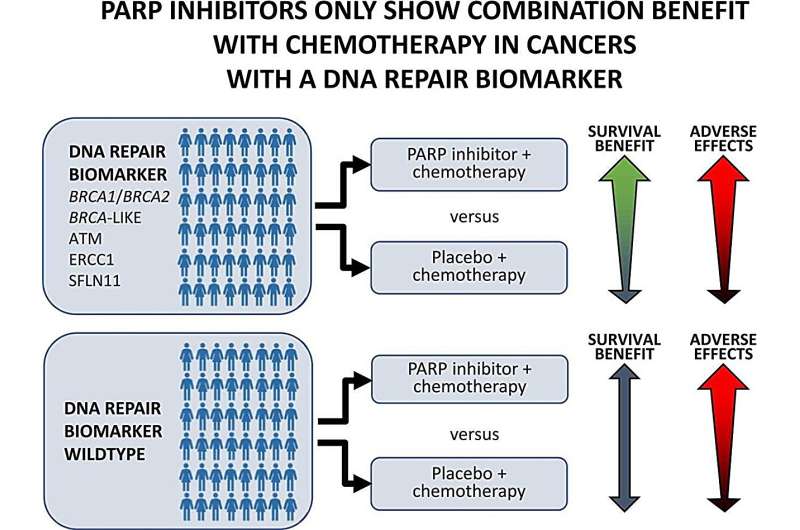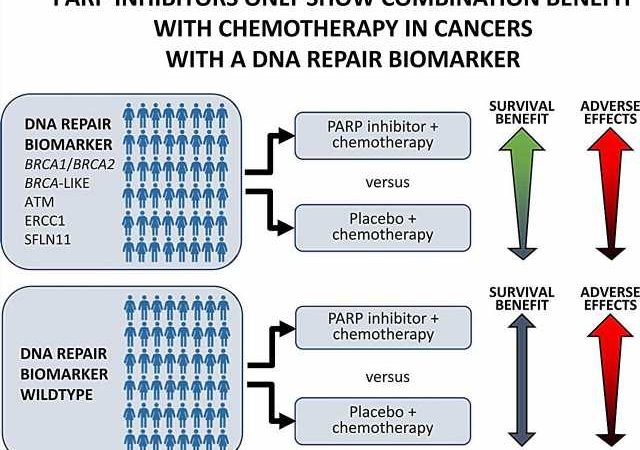
Researchers have identified genetic tests that predict which cancer patients may benefit from the drugs in combination with chemotherapy.
Testing for genetic “biomarkers” can predict which cancer patients are likely to benefit from DNA repair-blocking drugs called PARP inhibitors when combined with chemotherapy—an existing treatment approach for breast and ovarian cancers, new research reveals.
The findings provide a critical tool for identifying about 15% of cancer patients with a biomarker for whom the approach is likely to be effective, while reducing the risk of unnecessary side effects to other patients. The study, led by researchers at the Garvan Institute of Medical Research with co-authors from UNSW Sydney, was published recently in the journal Pharmacological Research.
“PARP inhibitors are a highly effective therapy for many patients with familial breast and ovarian cancers, but the response in other cancers has been mixed,” says UNSW Conjoint Associate Professor Liz Caldon, Head of the Replication and Genome Stability Lab at Garvan and senior author of the study.
“Our research indicates that genetic testing of cancers can predict how a patient will respond to PARP inhibitors when used with other cancer therapies, to help guide more personalized therapy for patients and prevent side effects for those unlikely to benefit.”
Test to match patients to effective therapies
Cancer is a leading cause of death worldwide, accounting for nearly 10 million deaths in 2020. In Australia, more than 150,000 people are diagnosed every year. A key driver of cancer is malfunctioning DNA repair, which prevents normal cells from fixing DNA errors that lead to the uncontrolled cell replication that is central to cancer growth.
While cancer cells have reduced DNA repair function, they need this function to survive and replicate. PARP inhibitors are drugs that block an enzyme that repairs DNA, called poly adenosine diphosphate-ribose polymerase, abolishing cancer cell’s ability to repair DNA altogether and delivering a fatal blow that prompts them to undergo programmed cell death.
“PARP inhibitors are currently administered to ovarian cancer patients who have mutations in the BRCA1/BRCA2 genes; however, clinical trials applying the treatment to other cancer types have had mixed results,” says Zoe Phan, a Ph.D. candidate at Garvan and first author of the study.
“As these drugs can have severe side effects, including neutropenia—the loss of white blood cells—we set out to determine whether screening for known DNA repair biomarkers could help predict treatment response when these drugs are used alongside chemotherapy.”
For the study, Caldon’s team analyzed the reported data from more than 80 cancer clinical trials worldwide, including 2,547 patients with breast, ovarian, lung and other cancers who had received a treatment of PARP inhibitors and chemotherapy.
The researchers found that patients who had one of six DNA repair biomarkers—changes in cancer cells that indicate defective DNA repair—had reduced disease progression and better survival than those who did not have one of these markers.
“Significantly, we found there was no benefit of adding PARP inhibitors to chemotherapy for patients who lacked the biomarkers we investigated,” says Caldon.
New hope for improved cancer therapy
The team is now working to integrate the biomarkers as inclusion criteria for patients who go on clinical trials for PARP inhibitors.
“At the moment, patients in clinical trials assessing PARP inhibitors in combination with chemotherapy are not always selected based on genetic biomarkers, which means the benefit of this combination therapy could be hidden,” says Caldon.
“More than 15% of all cancer patients are likely to have a DNA repair biomarker. This means that thousands of patients could potentially benefit from PARP inhibitors as a combination treatment.
“Our ultimate aim is to vastly improve outcomes for patients, not only by guiding more effective therapies but by reducing side effects and improving quality of life.”
More information:
Zoe Phan et al, DNA repair biomarkers to guide usage of combined PARP inhibitors and chemotherapy: A meta-analysis and systematic review, Pharmacological Research (2023). DOI: 10.1016/j.phrs.2023.106927
Journal information:
Pharmacological Research
Source: Read Full Article
